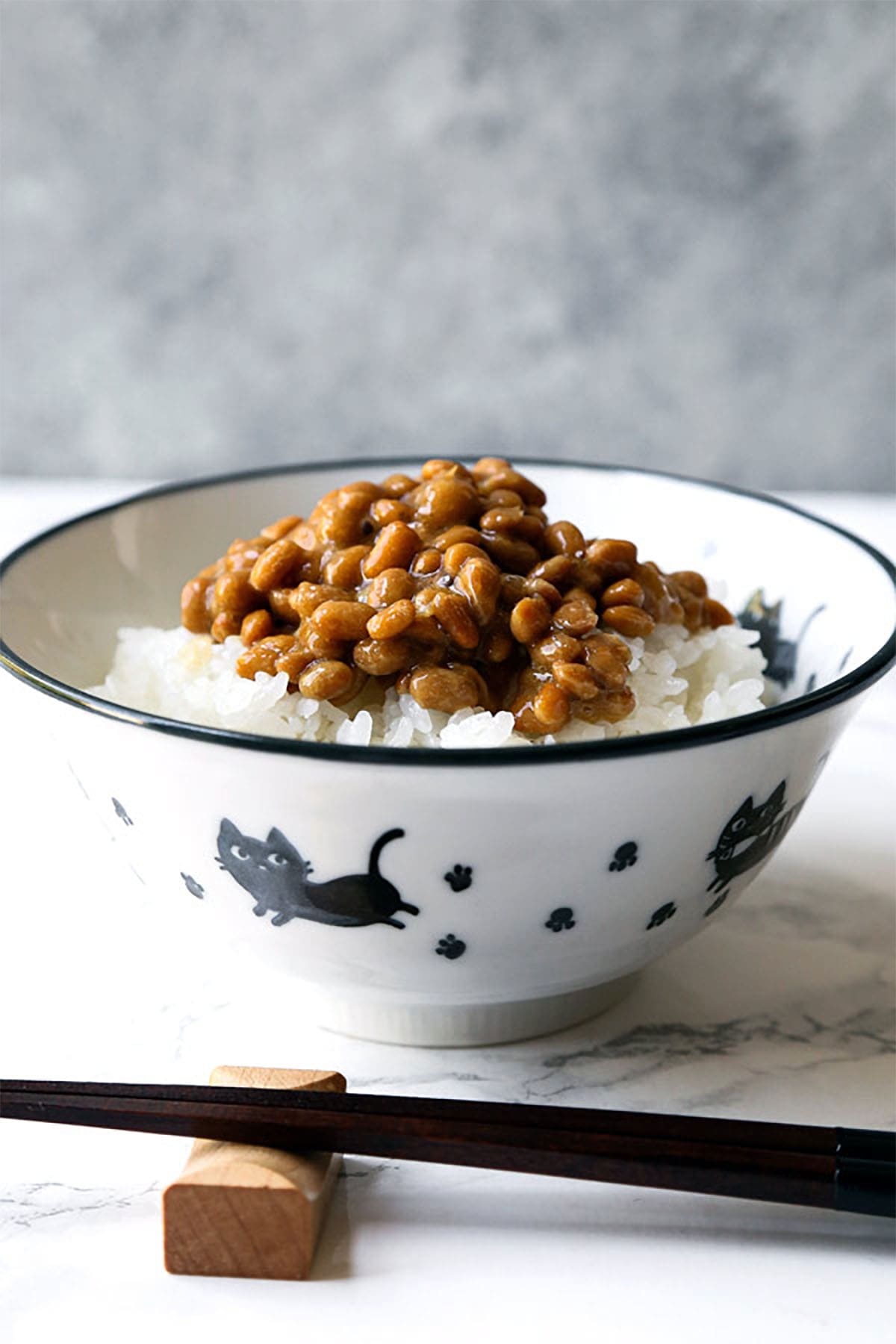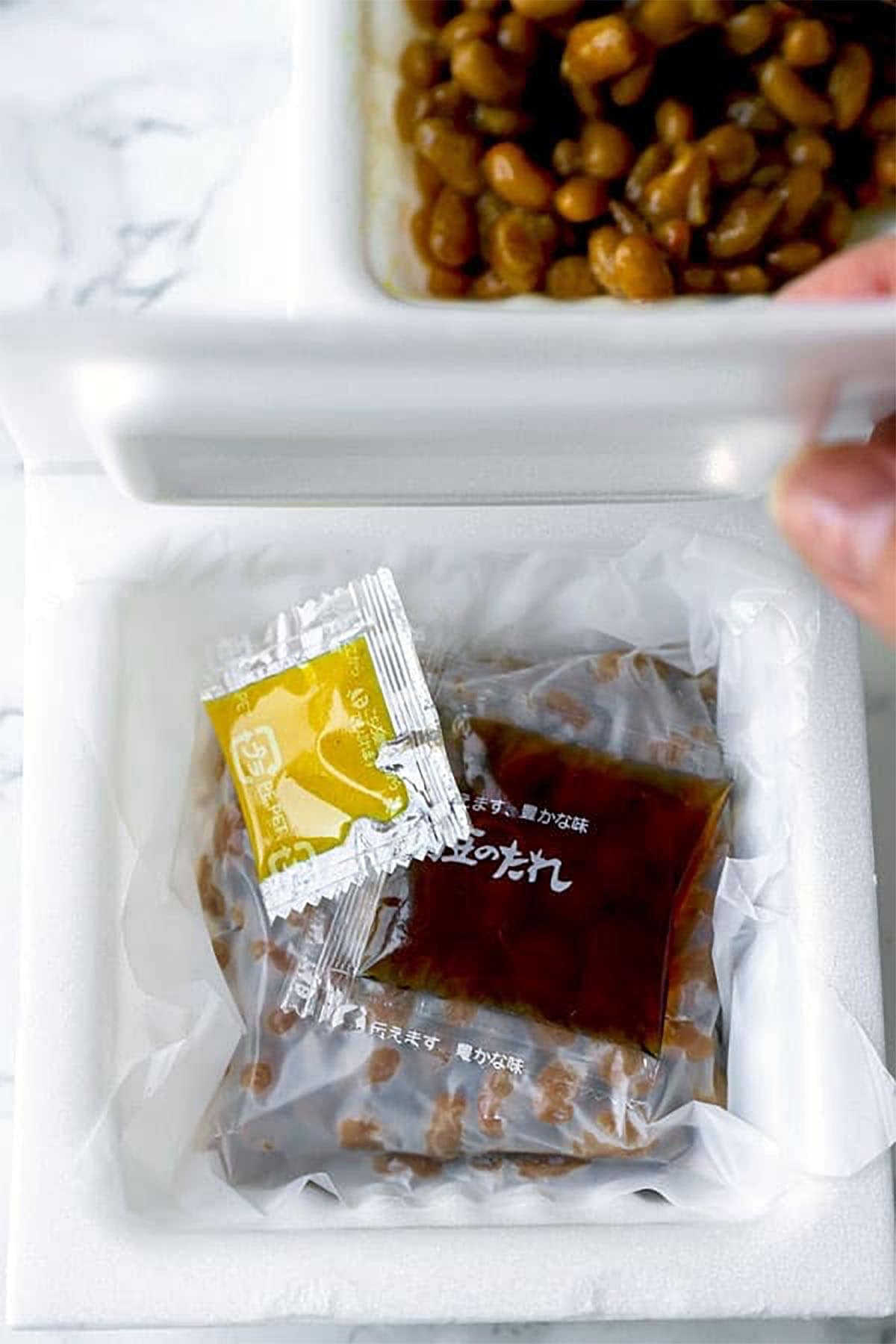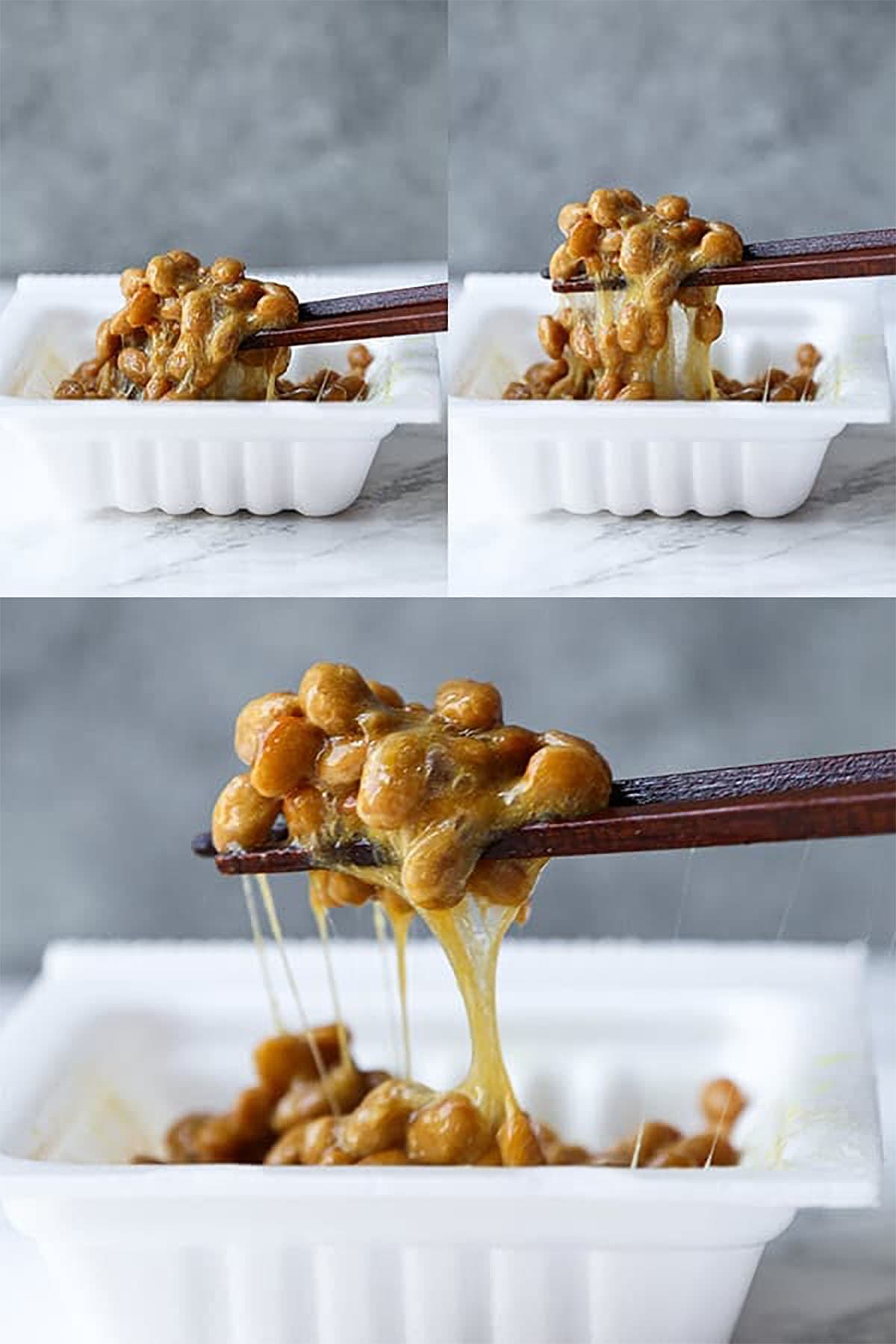When it comes to natto, you either love it or hate it. These fermented soybeans are known for their stinky smell, almost as famous as the durian fruit. I personally love it so today I’m sharing with you tips on how to make natto taste delicious.

The first time I tried natto was in Tokyo in my early 20s. I was having breakfast with my boyfriend at a family restaurant and had ordered the traditional Japanese breakfast. The meal consisted of salted grilled salmon (shiozake), tsukemono (Japanese pickles), miso soup, raw egg, a bowl of white rice, and a small bowl of natto.
I knew what natto was so I wasn’t surprised by it – I was ready to finally try it. I poured the stringy soybeans over the white rice and topped it with the raw egg. I finished with a drizzle of soy sauce and mixed the whole thing with chopsticks. “Here I go” I said to my boyfriend as I dug into my bowl of gooey creamy beans and rice.
To be honest, I expected to hate the taste.
So you can imagine my surprise when I found the flavor to be quite pleasant. Okay, it took me a minute to get used to the taste but there was something inherently addicting to this natto thing. I came back the next day and the day after that, specifically because I was craving the taste of natto. And that’s how I became obsessed with these stinky soybeans.
Nowadays I always have a few packets of natto sitting in my freezers since both Ben and I love to eat it over rice.

What is Natto?
Natto, or nattō (納豆), is a popular Japanese dish made of soybeans that have been fermented with bacillus subtilis bacteria over a certain period of time (usually between 24 to 36 hours). It’s often served as a breakfast food in Japan and has a very distinctive flavor and texture – stinky and slimy. It’s usually sold in individual portions, packaged in styrofoam that also include a tare sauce and yellow mustard.
Why is it Slimy?
The reason why natto is so slimy is because of the fermenting process that creates a sticky and stringy texture on the surface of the soybeans. The longer it ferments and the slimier and stinkier it gets.
Types of Natto
There are many different types of natto but the most popular ones come in four sizes: extra small, small, medium, and large.
- The extra small (gokuko tsubu) small (kotsubu) sizes are the most popular because they are easy to easy and the size and texture pair really well with rice.
- Medium (nakatsubu) and large (Otsubu) natto beans are more pungent, creamy, and chewy. Because of that they are often used in soups or mixed where they are mixed with other ingredients. But they can also be eaten on their own if you are a natto fanatic!
- Hikiwari, which are crushed natto beans, are most often used for maki rolls.
What Does Natto Taste Like?
Natto’s taste is extremely pungent and unique. Nothing else on this planet tastes quite like natto, you just have to try it to find out. But to give you an idea, natto lovers (including myself) would compare the taste to aged cheese, foie gras, or Marmite. It’s a major umami bomb.
And if you are wondering what it smells like, think of old socks or old cheese. The smell is truly the only downside to this wonderful and weird food.

Where to Buy Natto
You can buy packs of natto in Japanese supermarkets and Asian grocery stores. In New York for example you can find it at Sunrise Mart and places like Hong Kong supermarket in Chinatown.
In L.A., Japanese stores like Nijiya, Marukai, and Mitsuwa, carry many different brands of natto.
You can find natto in the freezer section or refrigerated next to tofu.
Best Natto Brands
There are a lot of brands to choose from, different flavors (wasabi, kimchi, pickled plum) and even types of beans. Some are broken up to be used in maki rolls while others are whole. While it’s fun to try a new brand or flavor once in a while, I do have a couple of favorites I keep going back to:
- Okame Kotsubu Mini – this brand is famous all across Japan. The brand is easy to recognize because of the traditional Japanese okame face mask found on the red packaging. What you get are whole natto soybeans with the traditional combination of tare and yellow mustard.
- Shirakiku “Kotsubu” Natto – again this brand offers the traditional tare and mustard flavor with whole beans.

How to Eat Natto
There are so many different ways to eat natto that to list them all would require me to start a blog just for that. Especially nowadays since you can find anything from natto ice cream, candy, pasta, even pizza! So I’ve decided to only list the most popular ways to eat natto along with one of my favorite natto recipes.
- Natto Over Rice with Scallions: Serving natto over warm Japanese rice (check out our guide to making perfect Japanese rice every time) with chopped scallions is the most traditional way to do it. Ben and I eat it this way often with a drizzle of soy sauce and a sprinkle of Ajinomoto.
- Natto Over Rice with Raw Egg: This is almost the same as the traditional version except with a raw egg on top. I love this style because the egg tones down the flavor of the nato and adds creaminess to the dish. Eating natto this way feels decadent!
How to Make Natto
Making natto at home is another option if you cannot find it at your local Asian grocery store.
Natto starter kits can be bought on sites such as Cultures For Health and come with natto spores and a special measuring spoon. You will have to purchase the soybeans separately.
I have never attempted to make my own but if you decide to give it a try, make sure to leave a comment below to let me know how it turned out!

My Favorite Natto Recipe
This is my favorite way to eat natto when I have it for lunch or dinner. It’s filling and super tasty.
The full recipe is available at the bottom of this post in the recipe card. It’s very easy and only takes about 10 minutes to make. You will need warm Japanese rice, diced cucumber, chopped avocado, and chopped green onions, to mix with the natto. A drizzle of soy sauce and some bonito flakes are added in the end to complete the meal (and a raw egg too if you want it extra creamy, but that’s optional).
The result is a bowl of natto rice that’s packed with savory, pungent, and umami flavors, with a light and creamy texture.
It’s so good and very filling!
Natto on Toast
This is another popular way Japanese people enjoy eating nattō. Since it’s considered a breakfast food, it only makes sense that it would eventually make its way onto a piece of toast.
You can have toast with butter and natto, paired with mayonnaise, or topped with cheese (all of which are very popular combinations).
Other ways to eat natto:
- Mediterranean style with feta cheese, shallots, and cherry tomatoes.
- As a topping with silken tofu and shredded nori.
- With kimchi over rice.
- In Miso Soup – yup, you can add it in your soup!

Can You Eat Natto Everyday?
Yes you can and there are many reason why you should!
Natto is considered to be a Japanese superfood because of its several health benefits. Natto is rich in probiotics because of its fermenation process, and therefore is very good for gut health because of its high content of beneficial bacteria. It’s also good for digestion since it’s high in dietary fiber, promoting regular bowel movements.
Natto is rich in calcium and vitamin K2, two nutrients excellent for bone health as they help slow down bone mineral density related to aging. These soybeans contain nattokinase, which are enzymes that help prevent and dissolve blood clotting and lower blood pressure.
What to Eat with Natto
Natto can be served as part of a meal or as a snack.
If you want to try your hands at making a full traditional Japanese breakfast, try pairing it with some of these yummy dishes:

Did you like this natto rice bowl recipe? Are there changes you made that you would like to share? Share your tips and recommendations in the comments section below!
Print
Natto Rice Bowl
- Prep Time: 10 minutes
- Cook Time: 0 minutes
- Total Time: 10 minutes
- Yield: 1 bowl 1x
- Category: Rice
- Method: None
- Cuisine: Japanese
- Diet: Vegetarian
Description
A delicious natto rice bowl filled with savory and umami packed flavors.
Ingredients
- 1 package natto
- 1/2 cup warm, cooked Japanese rice (preferably short grain)
- 1/2 avocado, chopped
- 1/2 cup English cucumber, seeded and diced
- 1 scallion, finely chopped
- Raw egg (optional)
- Soy sauce for drizzling
Instructions
- Place the rice in a bowl and top with the remaining ingredients. Serve immediately
Notes
If you bought natto frozen, leave it in the refrigerator overnight and it will be ready to eat the next day. Do not microwave!
Nutrition
- Serving Size: 1 bowl
- Calories: 328
- Sugar: 2.8g
- Sodium: 157.2mg
- Fat: 15g
- Saturated Fat: 2.1g
- Unsaturated Fat: 3.7g
- Trans Fat: 0g
- Carbohydrates: 38.7g
- Fiber: 7g
- Protein: 12.7g
- Cholesterol: 3.2mg















I’ve been making natto regularly for about 2 years. I love eating it with unseasoned oatmeal. The combination is rich with fiber. The hot oatmeal is a substitute for hot rice. Takes less time to cook amd has the benefit of glucan, which I understand slows the absorption of sugars. I keep a tube of Wasabi handy for quick flavor and kick. Another thing I like is to take some miso paste and mix it in for salty and sweet notes plus additional umami hit. Miso paste is also fermented and good for the digestion. Finally, I ferment my own Kim chi and enjoy ravishing the natto with chopped Kim chi and a dash of fish sauce. Quick, easy, these are my daily breakfast! Cheers.
That’s great, Jane! I have never tried natto with oatmeal, such an interesting combination and one I look forward to trying! Thanks for sharing 🙂
I make natto from TVP, cheaper than beans, FAR SUPERIOR! Especially texture! In a ratio of 33g TVP, 66G water, 2g sugar, 1g salt. The salt and sugar are essential. Usually make 4-500g at a time.reserve 15g water, rest mix together and pressure steam 17 minutes, wait for natural release, then cool to @120° heat other water mix water, salt sugar are starter and mix in TVP.. ferment in natto fermenter 24 hours. The natto taste is very faint or less, much stickier.
This is now my favorite way to eat Natto! I also sprinkle with some furikake.
I am trying to muster up the courage to try natto! I am very interested in it from an osteoporosis perspective connected to K2 (MK7/Mk4). Somewhere in a web article about how to eat natto, it suggested that one can put the natto in a toaster oven or your regular oven and bake them a little to dry them out so that they’re not as slimy. I believe the article said something about them ending up smelling a bit like sesame. Are you familiar with anything that I am mentioning?! Also, if you happen to have other resources to recommend to me, they are greatly appreciated. Thanks so much.
Hi Sherry! I am not familiar with baking natto but a great way to make natto less slimy is by mixing it with other ingredients. I like to use avocado and chopped spinach on top of rice. Or you can making sushi rolls also helps with the sliminess. It takes a minute to get used to natto but if you end up liking it, the slimy texture won’t be an issue 🙂
I made natto. It was delicious. The odd odor when it ferments dissipates when you “whip” it with chopsticks. As it ages in the refrigerator it supposedly fits a bit more funky. If find it creamy and soft in texture. The strings of biofilm (feels a little like “slimy” okra) do take some getting used to and god help you if you have a beard 🙂
That sounds greta, Ross. Do you happen to have the recipe that you used to make Natto?
Am I the only one on earth who thinks natto tastes and smells extremely mild, with a super-faint nutty/cheesy note? The only thing remarkable about it is the sticky sliminess, which I got used to. I must lack the taste receptors for that strong stinky cheese/Marmite flavor you guys are talking about. I eat natto straight out of the little styrofoam container with no rice, although my favorite preparation is mixed with cubed raw salmon, thinly sliced scallions, and a drizzle of soy sauce. For reference, I’m white American.
Natto with raw salmon, chopped scallions and soy sauce sounds so good!!!
You’re not the only one, I don’t really get natto’s reputation for being pungent! Perhaps I’m just used to eating “stinky” and strong flavoured food, like washed rind cheeses, marmite, various fermented foods etc, so in comparison natto seems very tame. I do really love natto though! I’ll have to try it with raw salmon sometime, I’ve eaten it as part of a breakfast with salted salmon before but I’ve never added salmon directly to it or had it with raw salmon. I often eat it mixed with soy sauce and some freshly grated horseradish, on top of rice.
I’ve always wanted to try this . today I went to the Asian market and there in the clearance section was a three pack of this for $.99 so for $.99 yeah give it a try. I lik d it. Yum
I have 4 different Natto sitting in my fridge while I muster up the courage to try it. This recipe is right up my alley! Definitely going to try this! Thank you!
Very interesting! I had natto for the first time today and I’m still processing the experience. I can handle the slimy stink but my boyfriend had to leave the room because of the smell, lol. Do you use a whole egg or only an egg yolk?
Hahaha! Yes, the smell will get you that’s for sure! I use just the egg yolk, it gives it a creamy texture and mellows the taste 🙂
I LOVE NATTO! It tastes like aged cheese to me as well. There’s a company in Brooklyn that makes it called Nyrture, I’m a huge fan. I’ve made it all the ways described above, plus I like it with hummus on toast!
Wow Elissa! Natto with hummus? I’ve never tried that combination! What does it taste like?
I have tried this recipe and it’s great!
Being pre-diabetic I have to be careful of the spikes that white rice can give. So I usually have my natto on top of oatmeal. Add a little soy sauce and furikake and its delicious. Love it.
Thank you for sharing this Neal! I’ve never tried natto with oatmeal but will give it a shot! 🙂
I also do natto on oatmeal! My current method: toss a piece of star anise in while cooking the oats and top with sour cherries and natto…Currently working on getting my partner on the natto train.
Would love to know where you purchased the little blue & white cat bowl and spoon that you posted with your recipe!!
Hi Deborah! I purchased the cat bowl at Hong Kong supermarket in Chinatown in Manhattan. The spoon was purchased in Japan, I fell in love as soon as I saw it 🙂 I unfortunately don’t remember where though…
I have been making my own Natto for years. I do it like the comment below except I don’t buy spores, just add a package of store bought Natto to the beans instead. I want to know a recipe for the packaged seasonings. Just Soy sauce is ok, but any better ideas you have would be great.
My sister in law is a Tokyo native and introduced me to natto a couple years back. I’ve been into making fermented foods for the last ten or fifteen years (kimchi, all kinds of pickles, yogurt, kombucha, etc.) and it never dawned on me to try making natto until a couple weeks ago.
Not that making any fermented foods is all that hard but natto is probably the easiest one I’ve tried. It takes from 36 – 48 hours (soaking = 12 hours, steaming = 45 minutes, fermenting = 24 hours) with about 10 minutes of actual hands on work – half that is cleaning the pots when you’re done. I use an instant pot for both cooking the beans and for the ferment (use the yogurt setting). I ordered my spores from Amazon, I think they’re the same ones that cultures for health sells.
I’m not enough of a natto connoisseur to say if mine is better than the store bought – I live in the sticks so getting natto is nigh impossible where I live. I can say that it is easy, cheap, and I think it tastes good. It’s also nice to not have all the packaging that normally comes with natto.
That’s wonderful Jacob! I will definitely try to make my own as I agree with you on the packaging situation – there’s just too much of it!